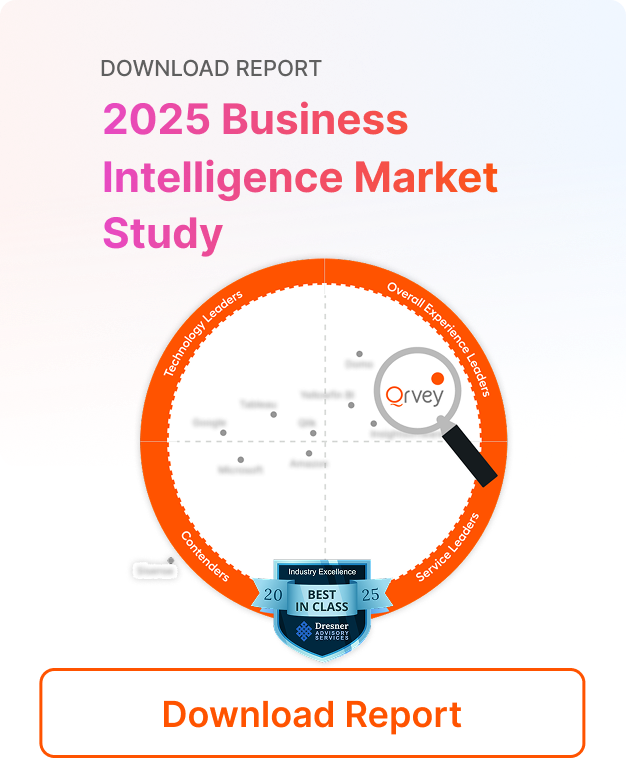
⚡Key Takeaways
- Agentic frameworks are the infrastructure behind autonomous AI agents, enabling them to perceive, plan, act, and learn independently.
- Core components include memory, planning, execution, and feedback—each essential for building intelligent, adaptive systems.
- Choosing the right framework depends on scalability, integration, governance, and adaptability to rapid tech evolution.
- Qrvey’s embedded analytics platform showcases how agentic frameworks can be deployed effectively in SaaS environments.
AI agents are revolutionizing how businesses operate, but their autonomy depends on a powerful underlying structure: the agentic framework. These frameworks allow agents to function independently, making decisions and executing tasks without constant human input. If you’re searching for the best agentic AI framework, this guide will give you a clear understanding of how they work, what components matter, and how platforms like Qrvey are using them to drive innovation. We’ll walk through the build process, key benefits, and challenges, so you can make informed decisions for your business.
What Are Agentic Frameworks?
Agentic frameworks are the infrastructure used to build and run autonomous AI agents. They define how agents perceive their environment, make decisions, and execute tasks—often without human intervention. These frameworks combine memory, planning, and execution layers to create intelligent systems capable of adapting to dynamic contexts and solving complex problems. In short, they are the operating system for autonomous intelligence.
Key Components of Agentic Frameworks
Memory Module
The memory module stores historical data, interactions, and decisions, allowing agents to learn from experience. It enables continuity across tasks, helping agents maintain context and avoid redundant actions. This component is critical for long-term learning and personalization. Without memory, agents would operate in isolation, unable to build on previous knowledge.
Planning Engine
The planning engine allows agents to break down goals into actionable steps and sequence them logically. It uses reasoning and prioritization to navigate complex workflows and adapt to changing conditions. This component is essential for autonomy, enabling agents to operate without constant human guidance. Effective planning ensures agents can handle multi-step tasks efficiently.
Execution Layer
The execution layer translates decisions into actions by interfacing with APIs, databases, and external systems. It ensures agents can interact with their environment reliably and securely. A robust execution layer supports real-time responsiveness and task completion. This component is the bridge between agent cognition and operational output.
Feedback Loop
Feedback loops allow agents to evaluate their actions and adjust future behavior based on outcomes. They compare results against goals, identify gaps, and refine strategies. This continuous learning process is key to building resilient and adaptive systems. Feedback ensures agents improve over time and remain aligned with objectives.
How Agentic Frameworks Work
Step #1: Goal Definition
The agent receives a goal—such as generating a report or optimizing a workflow. This goal can be user-defined or triggered by another system. The framework interprets the goal and prepares the agent to act. Clear goal definition sets the foundation for effective autonomous execution.
Step #2: Planning & Decomposition
The agent uses its planning engine to break the goal into subtasks and sequence them based on dependencies. It considers available resources, priorities, and constraints. This step ensures the agent can navigate complex workflows with minimal oversight. Planning transforms abstract goals into structured action plans.
Step #3: Execution
Each subtask is executed via the framework’s integration layer, involving data queries, API calls, or interactions with other agents. The execution layer ensures tasks are completed accurately and efficiently. It also handles error recovery and retries when needed. Execution is where agentic architecture meets operational reality.
Step #4: Feedback & Iteration
The agent evaluates its performance, identifies gaps, and refines its approach for future tasks. Feedback is gathered from outcomes, user input, or system signals. This loop enables continuous improvement and adaptability. Iteration ensures agents evolve and remain effective in dynamic environments.
Case Study: Qrvey in Action
Qrvey’s embedded AI analytics platform uses agentic principles to automate data workflows. As highlighted in Qrvey Incorporates Advanced AI into Embedded Analytics, its closed-loop system enables agents to analyze, visualize, and act on data autonomously.
The Importance of Adopting Agentic Frameworks in 2025
Scalability
Agentic frameworks allow businesses to scale operations without increasing headcount. Autonomous agents can handle repetitive tasks, freeing up human teams for strategic work. This scalability is essential for fast-growing SaaS companies. It enables organizations to do more with less while maintaining quality.
Competitive Advantage
Companies using agentic frameworks can respond faster to market changes and customer needs. Agents can analyze data, make decisions, and execute actions in real time. This agility gives businesses a strategic edge in dynamic environments. Early adoption of agentic systems can lead to long-term differentiation.
Product Innovation for SaaS Buyers
For SaaS companies, embedding agentic capabilities into their products signals innovation to their B2B customers. Buyers increasingly expect AI-powered features that improve efficiency and insight. Agentic frameworks allow SaaS vendors to deliver smarter, more autonomous tools. This can be a key differentiator in competitive markets.
Operational Efficiency
Agentic frameworks reduce the need for manual intervention in analytics, reporting, and decision-making. They streamline workflows and eliminate bottlenecks. This leads to faster turnaround times and better resource utilization. Efficiency gains can directly impact profitability and customer satisfaction.
Choosing the Right Agentic Framework For Your Needs
Integration Capabilities
Choose a framework that integrates seamlessly with your existing tech stack. Look for support for APIs, cloud services, and data pipelines to ensure smooth deployment. Integration flexibility reduces friction and accelerates time-to-value. A well-integrated framework enables agents to operate across systems effortlessly.
Governance & Security
Robust governance features are essential, especially in multi-agent environments. Ensure the framework supports role-based access, audit trails, and compliance with data regulations. Security must be built into every layer of the framework. Without proper governance, autonomous agents can introduce risk and complexity.
Flexibility & Adaptability
The AI landscape is evolving rapidly, and your framework must keep pace. Look for modular architectures that support plug-and-play components. Flexibility ensures you can adopt new models, standards, and tools as they emerge. Adaptability is key to future-proofing your agentic infrastructure.
Community & Ecosystem Support
A strong developer community and ecosystem can accelerate adoption and troubleshooting. Frameworks backed by active contributors often evolve faster and offer better documentation. Community support also means access to plugins, integrations, and shared best practices. Choose a framework that’s part of a thriving ecosystem.
Challenges in Implementing Agentic Frameworks
Technical Complexity
Building agentic systems requires deep expertise in AI, software architecture, and business logic. Teams must understand how to design agents that are both intelligent and reliable. The learning curve can be steep, especially for organizations new to autonomous systems. Technical complexity is a barrier—but not an insurmountable one.
Data Governance
Autonomous agents can introduce risks around data access, privacy, and compliance. Frameworks must include safeguards to prevent unauthorized actions and ensure transparency. Governance policies must be enforced consistently across agents. Without strong data governance, agentic systems can become liabilities instead of assets.
Rapid Technological Change
AI technologies and standards are evolving at breakneck speed. What’s cutting-edge today may be obsolete tomorrow. Frameworks must be designed to accommodate emerging standards like MCP (Multi-Agent Communication Protocol) and A2A (Agent-to-Agent). Staying current requires ongoing investment and architectural foresight.
Organizational Readiness
Agentic frameworks require a shift in mindset and workflows. Teams must be trained to collaborate with autonomous agents and trust their outputs. Resistance to change can slow adoption and reduce ROI. Organizational readiness is as important as technical capability.
While these challenges are real, they don’t have to be roadblocks. For SaaS companies seeking a faster path to agentic analytics, platforms like Qrvey offer a practical shortcut—embedding agentic capabilities without the need to build a full framework from scratch.
Qrvey’s Solution: Its embedded analytics system provides secure, governed agent behavior with built-in compliance features, a key advantage in the evolving landscape of AI in SaaS Embedded Analytics.
Final Note on Agentic Frameworks & Qrvey
Agentic frameworks are reshaping how AI agents operate—but not every SaaS company needs to build one from the ground up. In fact, many will benefit from adopting agentic platforms within their own products to meet emerging customer expectations. Qrvey’s embedded analytics system, with its agentic design and closed-loop intelligence, gives SaaS vendors a head start. By integrating Qrvey, they can begin offering agentic analytics features—such as autonomous data workflows and adaptive visualizations—without solving every architectural challenge upfront. It’s a strategic way to accelerate innovation while staying focused on core product value.

Arman Eshraghi is the CEO and founder of Qrvey, the leading embedded analytics solution for SaaS companies. With over 25 years of experience in data analytics and software development, Arman has a deep passion for empowering businesses to unlock the full potential of their data.
His extensive expertise in data architecture, machine learning, and cloud computing has been instrumental in shaping Qrvey’s innovative approach to embedded analytics. As the driving force behind Qrvey, Arman is committed to revolutionizing the way SaaS companies deliver data-driven experiences to their customers. With a keen understanding of the unique challenges faced by SaaS businesses, he has led the development of a platform that seamlessly integrates advanced analytics capabilities into software applications, enabling companies to provide valuable insights and drive growth.
Popular Posts
Why is Multi-Tenant Analytics So Hard?
BLOG
Creating performant, secure, and scalable multi-tenant analytics requires overcoming steep engineering challenges that stretch the limits of...
How We Define Embedded Analytics
BLOG
Embedded analytics comes in many forms, but at Qrvey we focus exclusively on embedded analytics for SaaS applications. Discover the differences here...
White Labeling Your Analytics for Success
BLOG
When using third party analytics software you want it to blend in seamlessly to your application. Learn more on how and why this is important for user experience.








